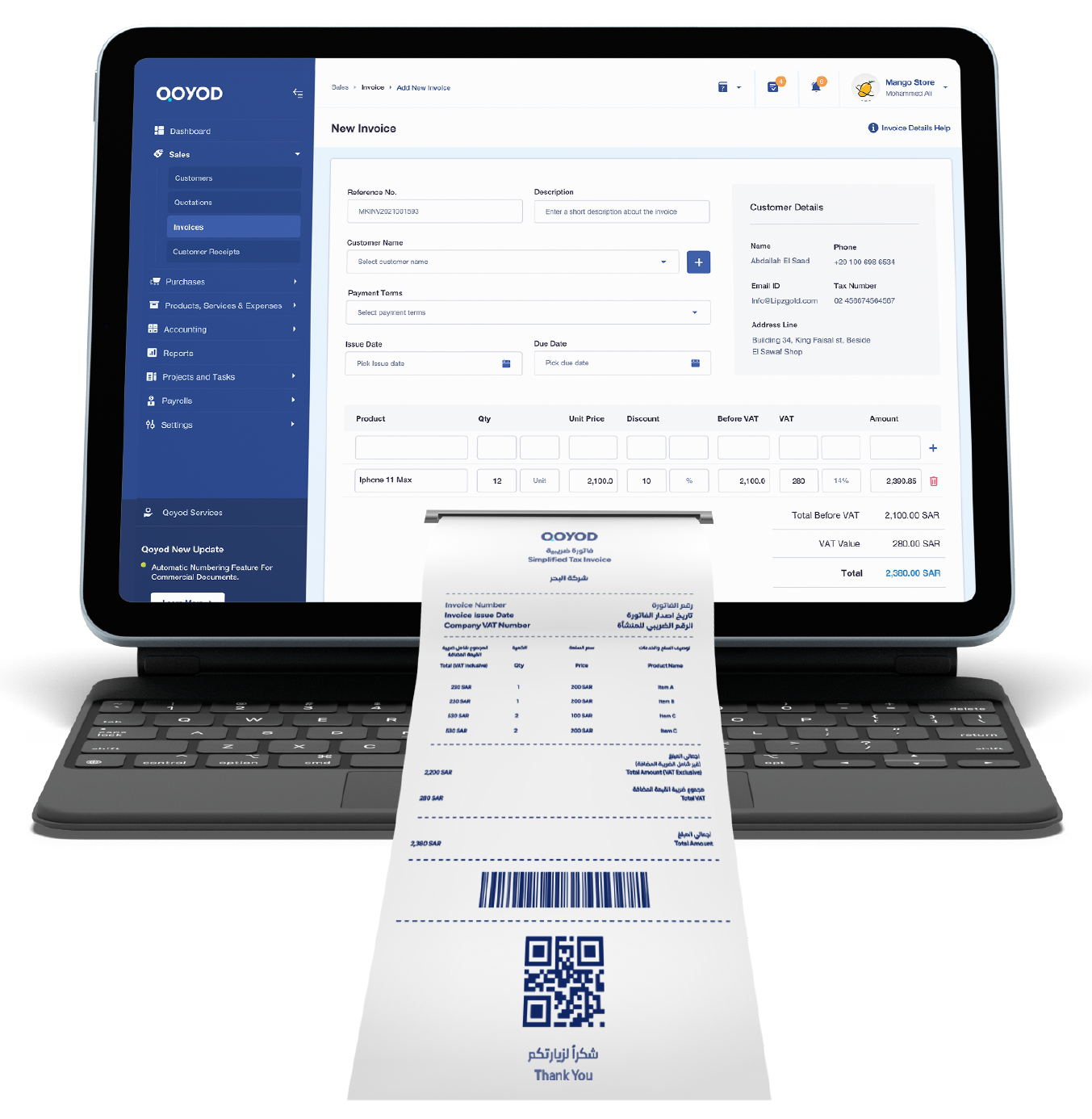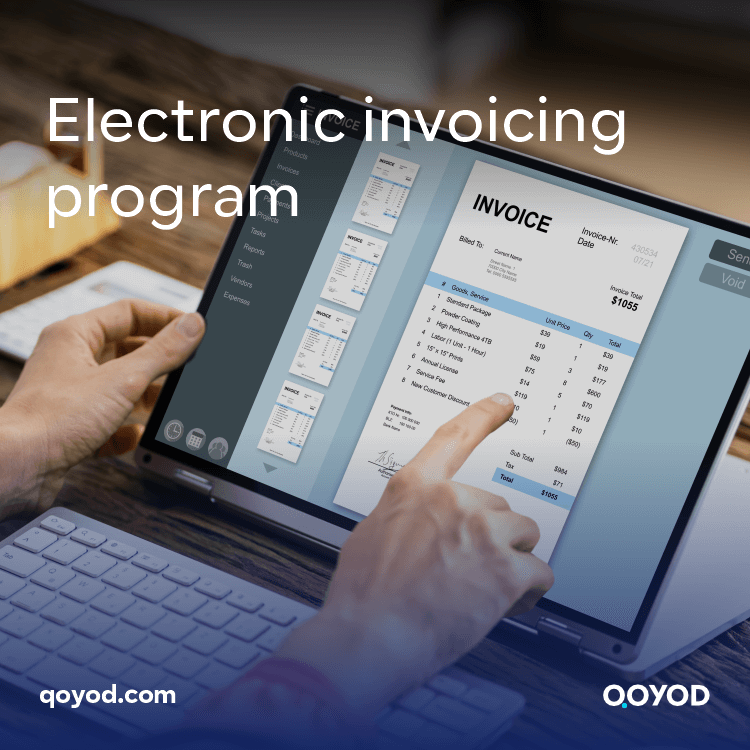Welcome to the era of electronic invoicing, where folding papers turn into sparkling details on glossy screens and traditional magic buttons disappear in front of the charming touches of light rays. It is a revolutionary technology that combines the power of creative writing with the magic of visual impact. It is also an enchanting combination that allows words and images to transform into incredible dimensions as physical rigidity disappears and electronic paper comes alive with a new spirit. In this article, we will explore the world of the electronic invoice and discover its amazing secret, so get ready to soar with us into a new world of imagination and creativity, as we are on the cusp of discovering this world. Follow along with us.
What is electronic invoicing?
It is a system that aims to transform the process of issuing paper invoices and notices into an electronic process. This system allows the exchange of invoices and debit and credit notices between the seller and the buyer directly electronically, and they are processed in an organized and integrated electronic format.
What is the importance of electronic invoices?
With the development of technology, increased use of the Internet, and the trend towards digitization, electronic invoicing is a sustainable and effective option for companies and institutions, simplifying and improving the process of issuing invoices and notifications and enhancing efficiency and communication between concerned parties. It is worth noting that it is characterized by several main points, the most important of which are the following:
Cost savings
Instead of using paper, ink, and postage, companies can send invoices and electronic notices via email or dedicated electronic systems, saving on printing, mailing, and distribution costs, which leads to improving work efficiency and reducing overhead costs.
Speed and effectiveness
Electronic invoicing allows invoices and notices to be sent immediately without having to wait for them to arrive by traditional mail. Businesses can also receive payments more quickly, as customers can pay through available electronic payment methods.
Tracking and monitoring
Thanks to electronic invoices, it becomes easy to track the date of issuance of invoices, monitor their status, and verify their receipt, as companies can generate detailed reports on invoices and payments received. Thus improving account management and reducing late payment periods.
Security and reliability
Electronic invoicing relies on encryption and digital signature technologies. To ensure the confidentiality and security of information, it provides mechanisms to verify the identity of the sender and recipient and to ensure that documents are not modified during transfer.
Professionalism and flexibility
An electronic invoice enhances the company’s image and credibility, as invoices and notices can be professionally customized, company logos and contact information can be added, and templates can be easily modified and adapted according to the company’s needs.
Stages of implementing electronic invoicing
The application of the electronic invoice usually takes place through several stages aimed at ensuring its correct implementation in accordance with legal and regulatory requirements. Below, I will review for you the most important main points for each stage:
The first stage
The first phase of implementing electronic invoicing begins on December 4, 2021 AD, and includes the issuance and preservation phases. During this phase, all persons subject to the electronic invoicing list, in addition to authorized representatives, will be able to issue these invoices.
The process of issuing electronic invoices at this stage is done in the same way as traditional invoices, using a compatible electronic invoicing system. It is worth noting that electronic invoices contain all the required elements according to the type of invoice, such as the necessary information about the seller and buyer, details of the goods or service provided, and their value.
The second phase
The second phase of implementing the electronic invoice begins on January 1, 2023 AD. At this stage, the electronic solution is required to be integrated with the Zakat, Tax, and Customs Authority’s Zatca system, and compliance with all tax rules and instructions is guaranteed through seamless integration between the electronic solution and the authority’s system.
At this stage, electronic invoices must be issued in the required format in accordance with legal and regulatory requirements and must include full details of the business process, such as applicable taxes as well as appropriate tax codes.
Conditions for applying the electronic invoice at this stage
The second stage of electronic invoicing requires the fulfillment of a number of basic conditions and requirements, the most important of which are the following:
Use an online technical solution.
You must use a technical solution that provides electronic billing services and is connected to the Internet. Therefore, this allows data to be exchanged between transacting parties, such as companies and government agencies, in a safe and reliable manner.
Linking the technical solution to the “Fateora” platform
Implementing electronic invoicing in the second stage requires linking the technical solution to the “Fatora” platform, which is the platform affiliated with the Zakat, Tax, and Customs Authority. Therefore, this link ensures compatibility with the regulations and standards specified by the authority and facilitates the process of communication and data exchange between concerned parties.
All requirements are met in the electronic invoice.
The invoice must include all specified requirements, such as: additional fields and necessary data; To learn about the business process and invoice details, it is worth noting that the invoice must be compatible with the approved styles and formats in order to ensure that the data can be read and understood correctly.
Use XML or PDF/A3 formats, including XML.
Specific formats should be used to save and issue electronic invoices, which are XML or PDF/A3 formats, including XML. It is worth noting that the XML format is used to represent invoice data in a structured and analyzable manner, while the PDF/A3 format is used to include data in PDF format. Thus, this ensures that invoices are easy to keep and access in the future.
Electronic invoice elements in the second stage
The elements of the electronic invoice in the second stage, according to its terms, consist of two types:
Simplified tax invoice
Elements of a simplified tax invoice include:
- Invoice title: includes information that identifies the source of the invoice and makes it easier to identify.
- Invoice number: represents a unique serial number for each invoice and helps in tracking and classifying it.
- Name of the company or facility: indicates the name of the company or facility that issues the invoice.
- Company/Facility Address: Includes full address information for the company or facility.
- Invoice Issue Date: Indicates the date the invoice was issued and helps determine the time it was issued.
- VAT registration number: reflects the tax registration number of the company or establishment.
- The total value of the added tax applied to the invoice represents the total value of the tax that was applied to the invoice.
- Invoice items/items: It includes details of the products or services provided in the invoice, such as quantity, unit price, tax value, etc.
- Total price of items or items without added value: Reflects the total price of the items or items on the invoice before adding tax.
- Quick Response Code (QR Code): It is a code that contains billing information encoded in digital form and can be read using smartphones.
- Total Invoice: Refers to the total amount of the invoice after adding the tax value of the items.
tax invoice
Tax invoice elements include:
- Invoice title: includes information that identifies the source of the invoice and makes it easier to identify.
- Invoice number: represents a unique serial number for each invoice and helps in tracking and classifying invoices.
- The total value of the added tax applied to the invoice represents the total value of the tax that was applied to the invoice.
- Invoice Issue Date: Indicates the date the invoice was issued and helps determine the time it was issued.
- Total Invoice: Refers to the total amount of the invoice after adding the tax value of the items.
- Seller information includes the seller’s information, such as his name, address, value-added tax registration number, and commercial registration number.
- Invoice items/items: It includes details of the products or services provided in the invoice, such as quantity, unit price, and tax value.
- Buyer information includes the buyer’s information, such as his name, address, value-added tax registration number, and commercial registration number.
- Total price of items or items without added value: Reflects the total price of the items or items on the invoice before adding tax.
- Quick Response Code (QR Code): It is a code that contains billing information encoded in digital form and can be read using smartphones.
Who is obligated to apply the electronic invoice?
The electronic billing system requires its application by several parties in accordance with the decision issued in this regard. Here are the people obligated to apply the bill:
Tax residents
This section includes people who carry out commercial, financial, and economic activities in the country, as they must apply electronic invoicing for all tax invoices they issue or receive.
B2B tax invoices
This type of invoice includes invoices issued or received by the tax resident to and from other parties carrying out commercial and economic activities, as these parties must also apply electronic invoices and adhere to their requirements.
Simplified tax invoicing (B2C)
This type of invoice includes commercial transactions between individuals and government institutions, as the parties involved must apply electronic invoices in this case as well.
In addition, concerned parties must apply debit and credit notices electronically in order to record transactions related to discounts and receivables between different parties. It is worth noting that the application of electronic invoices in this context enhances transparency and accuracy in recording these transactions.
Conclusion
Electronic invoicing is a revolutionary technology that facilitates and improves the process of issuing invoices and making payments electronically. It is also an innovative alternative to traditional printed invoices, as it offers many practical and economic advantages. It is worth noting that it relies on the use of digital technology to create and send invoices and transfer the amounts due securely. In addition, this technology provides great flexibility in customizing and designing invoices, adding the necessary details, tracking and recording payments, and providing accurate financial reports. Among the basic benefits of electronic invoicing are: reducing the costs and time associated with the traditional invoicing process; eliminating the need for printing, mailing, and paper distribution; and saving resources and additional costs.
Let us adopt modern electronic invoice technology and take advantage of its benefits in our advanced and connected world with the Qoyod program. It is worth noting that the program also offers all its clients electronic invoice systems as well as point-of-sale systems, warehouses, customers, etc. This is an accounting program preferred by small and medium-sized companies in the Kingdom of Saudi Arabia.

After you know what electronic invoicing is, try Qoyod now for free for 14 days; you won’t regret it. It is an accounting program that reshapes the business world so that your company or organization reaches the top.




